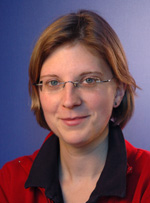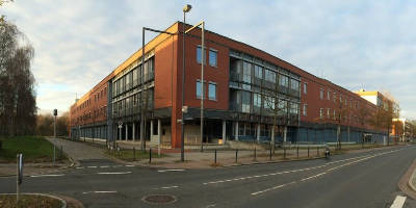← students

| First name: | Dagmar |
| Last name: | Woebken |
| Country: | Germany |
| Education: | |
| since Sept. 2007
Post-doctoral Fellow Nutrient Group Max Planck Institute for Marine Microbiology, Bremen, Germany |
|
| June-August 2007 Teaching assistant for Microbial Diversity Course, MBL, Woods Hole, MA, USA | |
| Febr. 2004-May 2007
PhD student in the department of Molecular Ecology at MPI for Marine Microbiology, Bremen, Germany Thesis Subject: Diversity and in situ abundance of Planctomycetes in marine ecosystems |
|
| 2003
Diploma thesis at Max Planck Institute for Marine Microbiology, Bremen, Germany Title: Comparative molecular analysis of bacterioplankton inhabiting the oxic and suboxic marine pelagial |
|
| 2000-2001
Graduate courses in Molecular Cell Biology and Biochemistry, Marine Invertebrates and Electron Microscopy Northeastern University, Boston, MA, USA |
|
| 1997-2002
Undergraduate and graduate studies in Biology University of Hannover, Germany Graduate courses in Microbiology, Molecular Biology, Hydrobiology, Zoology |
Scientific Interests and Goals:I am mainly interested in studying the diversity and in situ abundance of marine Planctomycetes which mediate the anaerobic oxidation of ammonium (anammox) by nitrite to dinitrogen gas. We could show that the anammox process plays an important role in catalyzing the loss of nitrogen from marine oxygen minimum zones (OMZ) (see publication 3 and 4). However, in situ oxygen concentrations of up to 25 µM and ammonium concentrations close to or below detection limit in the layer of anammox activity are hard to reconcile with current knowledge of the physiology of anammox bacteria.
Investigation of samples from the Namibian OMZ with fluorescence in situ hybridization showed, that marine anammox bacteria colonize microscopic particles that are likely the remains of either macroscopic marine snow particles or resuspended particles. In these aggregates, the relative abundance of Gammaproteobacteria is significantly enriched (12%) compared to the free water phase (8%). Members of the Alphaproteobacteria and Bacteroidetes occur in particles and in the free water phase with ~ 12% relative abundance. Aerobic respiration of these heterotrophic bacteria could decrease the oxygen concentration in the particles compared to the surrounding water thereby creating anaerobic micro niches for the oxygen sensitive anammox bacteria. We hypothesize that the heterotrophic bacteria can produce hydrolytic exoenzymes and degrade proteins to ammonium, which is subsequently used by anammox bacteria. In the free water phase, Crenarchaeota are highly abundant (15%), the majority of them with 99% 16S rRNA sequence identity to the nitrifying Candidatus Nitrosopumilus maritimus. The Crenarchaeota in the free water phase might be a source of nitrite for the anammox reaction.
In addition to the particle association of anammox bacteria, I am interested in their microdiversity, which I am studying by comparative phylogenetic analysis of 16S rRNA gene sequences and intergenic transcribed spacers (ITS).
Investigation of samples from the Namibian OMZ with fluorescence in situ hybridization showed, that marine anammox bacteria colonize microscopic particles that are likely the remains of either macroscopic marine snow particles or resuspended particles. In these aggregates, the relative abundance of Gammaproteobacteria is significantly enriched (12%) compared to the free water phase (8%). Members of the Alphaproteobacteria and Bacteroidetes occur in particles and in the free water phase with ~ 12% relative abundance. Aerobic respiration of these heterotrophic bacteria could decrease the oxygen concentration in the particles compared to the surrounding water thereby creating anaerobic micro niches for the oxygen sensitive anammox bacteria. We hypothesize that the heterotrophic bacteria can produce hydrolytic exoenzymes and degrade proteins to ammonium, which is subsequently used by anammox bacteria. In the free water phase, Crenarchaeota are highly abundant (15%), the majority of them with 99% 16S rRNA sequence identity to the nitrifying Candidatus Nitrosopumilus maritimus. The Crenarchaeota in the free water phase might be a source of nitrite for the anammox reaction.
In addition to the particle association of anammox bacteria, I am interested in their microdiversity, which I am studying by comparative phylogenetic analysis of 16S rRNA gene sequences and intergenic transcribed spacers (ITS).
Selected Publications:1. Dagmar Woebken, Bernhard M. Fuchs, Marcel M. M. Kuypers, Rudolf Amann. 2007. Potential interactions of particle-associated anammox bacteria with bacterial and archaeal partners in the Namibian upwelling system. Appl.Env.Microbiol. 73: 4648-4657.
2. Dagmar Woebken, Hanno Teeling, Alexandra Dumitriu, Ivaylo Kostadinov, Rudolf Amann and Frank O. Glöckner. 2007. Fosmids of novel marine Planctomycetes from the Namibian and Oregon coast upwelling systems and their cross-comparison with planctomycete genomes. ISME Journal 1: 419-435
2. Fuchs, B.M., Woebken, D., Zubkov, M.V., Burkill, P., Amann, R., Molecular identification of picoplankton populations in contrasting waters of the Arabian Sea, (2005), Aquat. Microb. Ecol. 39: 145-157
3. Kuypers, M.M.M., Lavik, G., Woebken. D., Schmid, M., Fuchs, B.M., Amann, R., Jorgensen, B.B., Jetten, S.M., Massive nitrogen loss from the Benguela upwelling system through anaerobic ammonium oxidation (2005), PNAS 102: 6478-6483
4. Hamersley M. R, Lavik G., Woebken D., Rattray J. E., Lam P., Hopmans E. C., Sinninghe Damsté J. S., Krüger S., Graco M., Gutiérrez D., and Kuypers M. M. M., Anaerobic ammonium oxidation in the hypoxic waters of the Peruvian upwelling, L&O 52: 923-933.
5. Michael Hannig, Gaute Lavik, Marcel M.M. Kuypers, Dagmar Woebken, Willm Martens-Habbena, and Klaus Jürgens. 2007. Shift from denitrification to anammox after inflow events in the central Baltic Sea. L&O 52: 1336-1345.
6. Bauer, M., Michael Kube, Hanno Teeling, Michael Richter, Thierry Lombardot, Elke Allers, Chris A. Wurdemann, Christian Quast, Heiner Kuhl, Florian Knaust, Dagmar Woebken, Kerstin Bischof, Marc Mussmann, Jornuna V. Choudhuri, Folker Meyer, Richard Reinhardt, Rudolf Amann, and Frank O. Glöckner. 2006. Whole genome analysis of the marine Bacteroidetes 'Gramella forsetii' reveals adaptations to degradation of polymeric organic matter. Env. Microbiol. 8: 2201-2213.
2. Dagmar Woebken, Hanno Teeling, Alexandra Dumitriu, Ivaylo Kostadinov, Rudolf Amann and Frank O. Glöckner. 2007. Fosmids of novel marine Planctomycetes from the Namibian and Oregon coast upwelling systems and their cross-comparison with planctomycete genomes. ISME Journal 1: 419-435
2. Fuchs, B.M., Woebken, D., Zubkov, M.V., Burkill, P., Amann, R., Molecular identification of picoplankton populations in contrasting waters of the Arabian Sea, (2005), Aquat. Microb. Ecol. 39: 145-157
3. Kuypers, M.M.M., Lavik, G., Woebken. D., Schmid, M., Fuchs, B.M., Amann, R., Jorgensen, B.B., Jetten, S.M., Massive nitrogen loss from the Benguela upwelling system through anaerobic ammonium oxidation (2005), PNAS 102: 6478-6483
4. Hamersley M. R, Lavik G., Woebken D., Rattray J. E., Lam P., Hopmans E. C., Sinninghe Damsté J. S., Krüger S., Graco M., Gutiérrez D., and Kuypers M. M. M., Anaerobic ammonium oxidation in the hypoxic waters of the Peruvian upwelling, L&O 52: 923-933.
5. Michael Hannig, Gaute Lavik, Marcel M.M. Kuypers, Dagmar Woebken, Willm Martens-Habbena, and Klaus Jürgens. 2007. Shift from denitrification to anammox after inflow events in the central Baltic Sea. L&O 52: 1336-1345.
6. Bauer, M., Michael Kube, Hanno Teeling, Michael Richter, Thierry Lombardot, Elke Allers, Chris A. Wurdemann, Christian Quast, Heiner Kuhl, Florian Knaust, Dagmar Woebken, Kerstin Bischof, Marc Mussmann, Jornuna V. Choudhuri, Folker Meyer, Richard Reinhardt, Rudolf Amann, and Frank O. Glöckner. 2006. Whole genome analysis of the marine Bacteroidetes 'Gramella forsetii' reveals adaptations to degradation of polymeric organic matter. Env. Microbiol. 8: 2201-2213.


